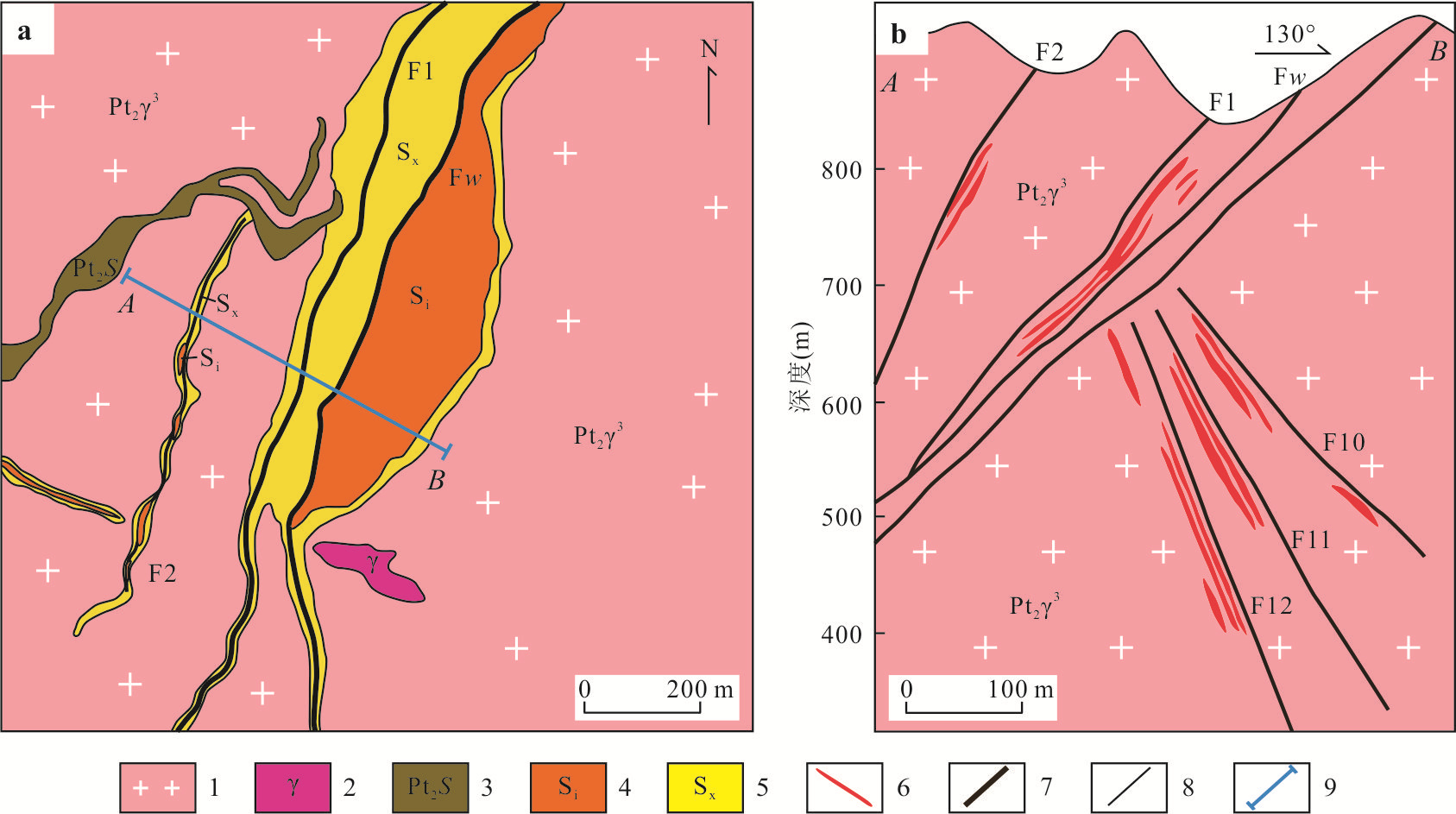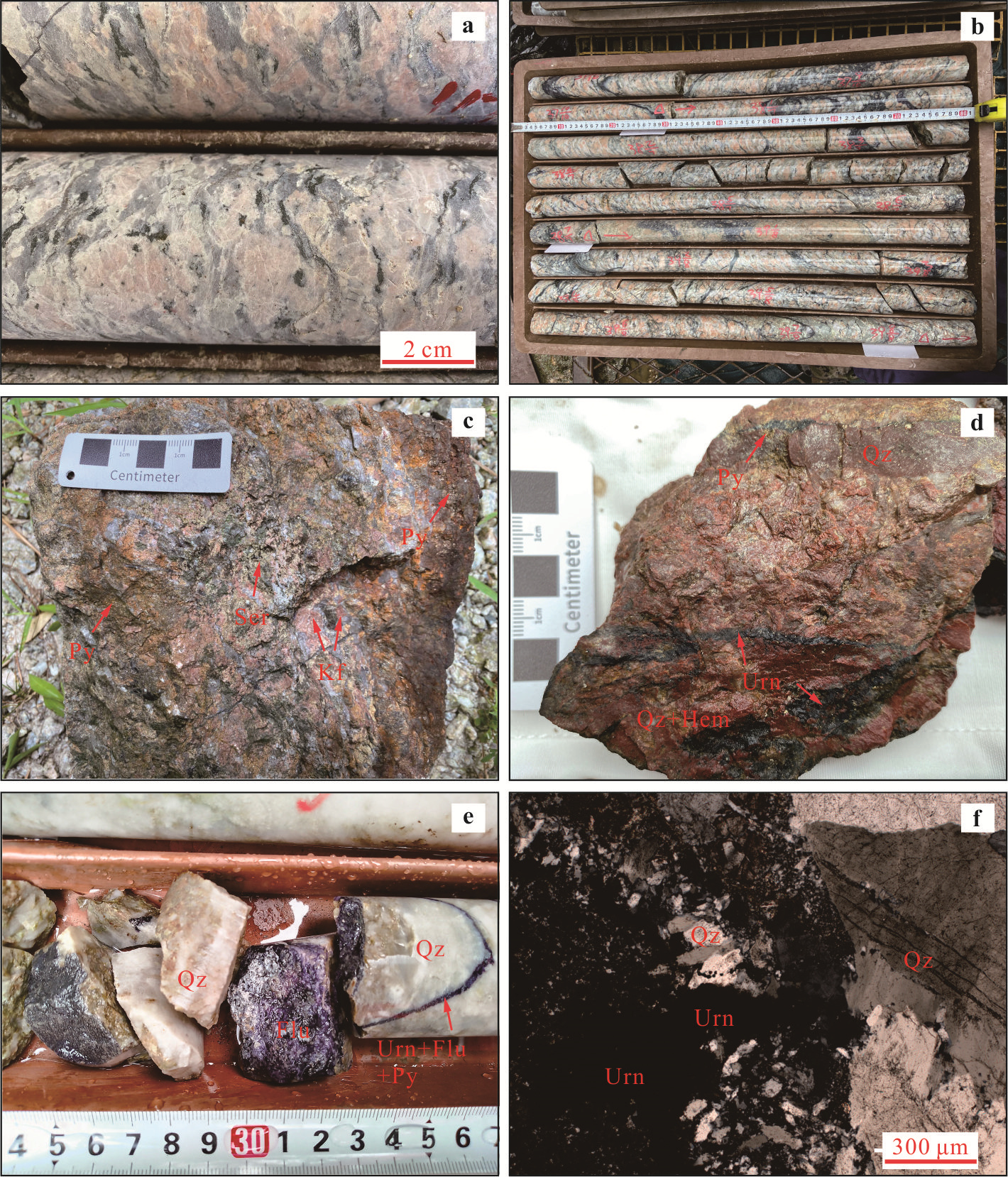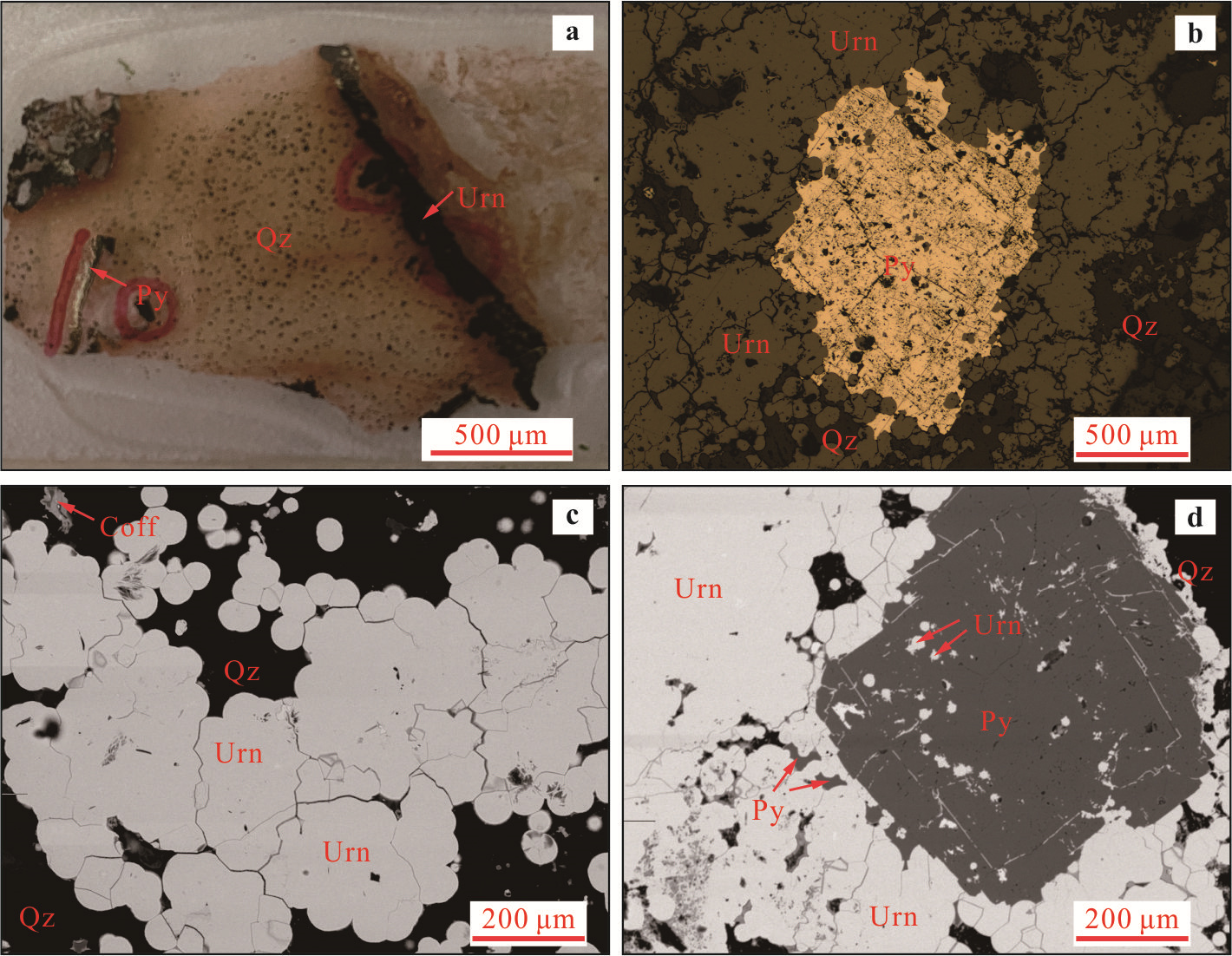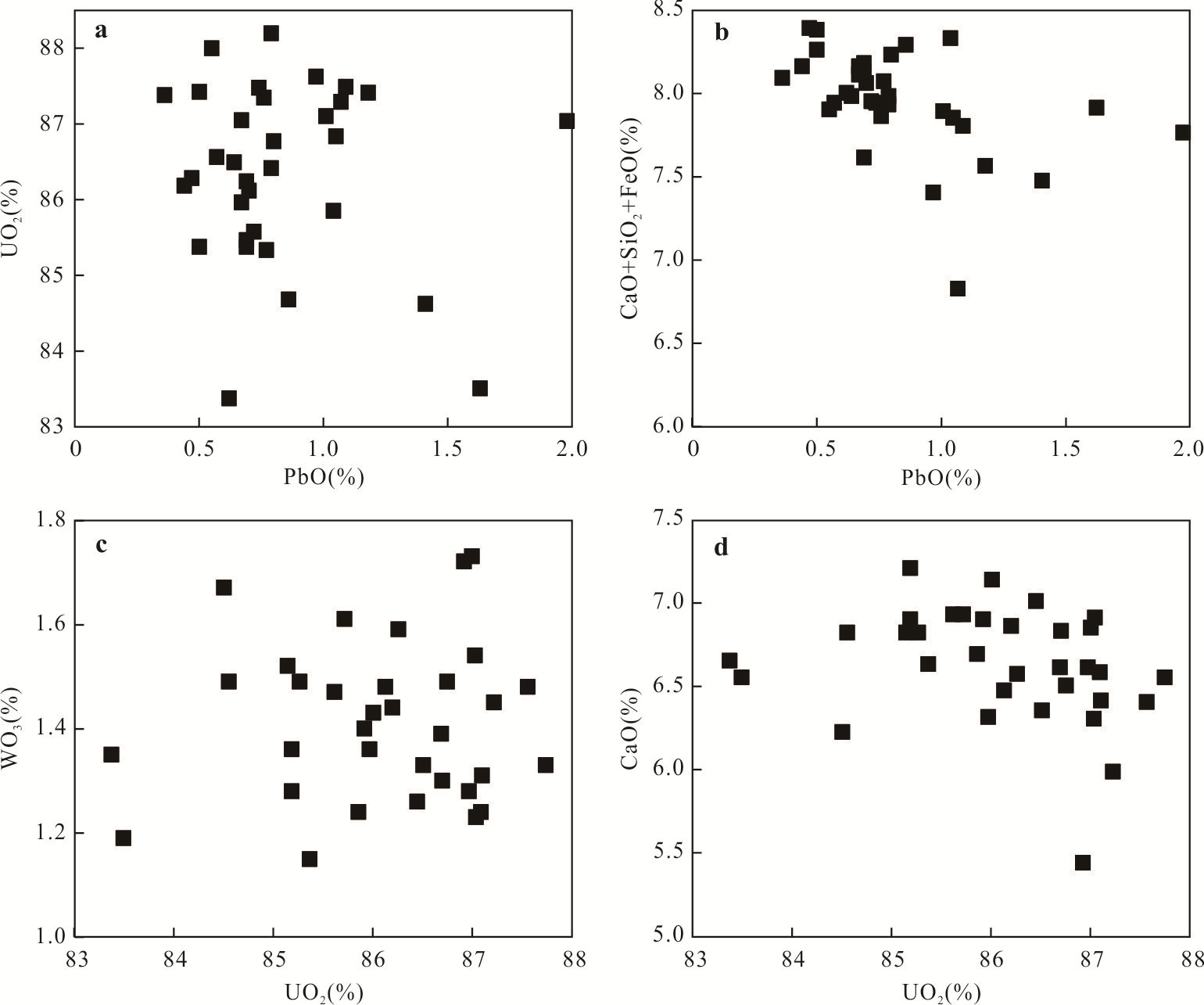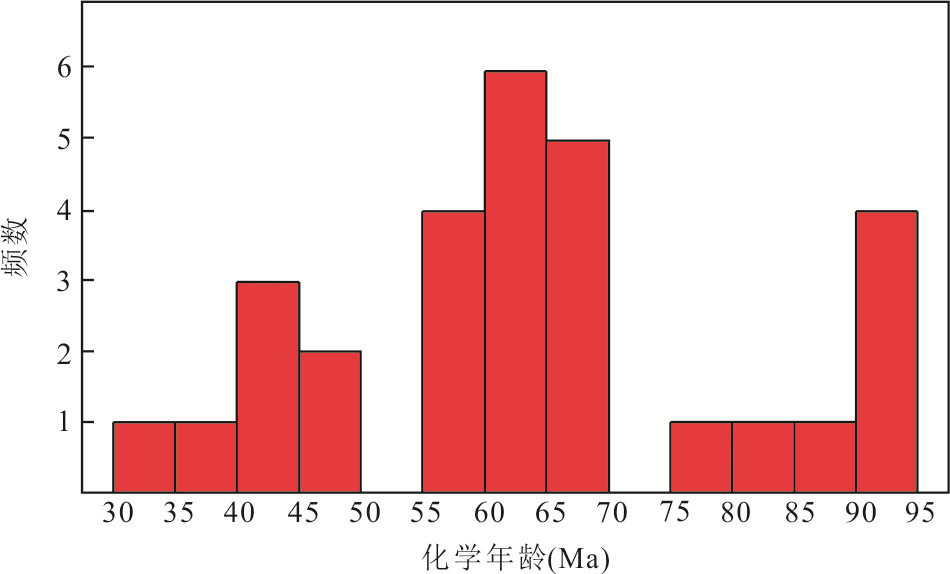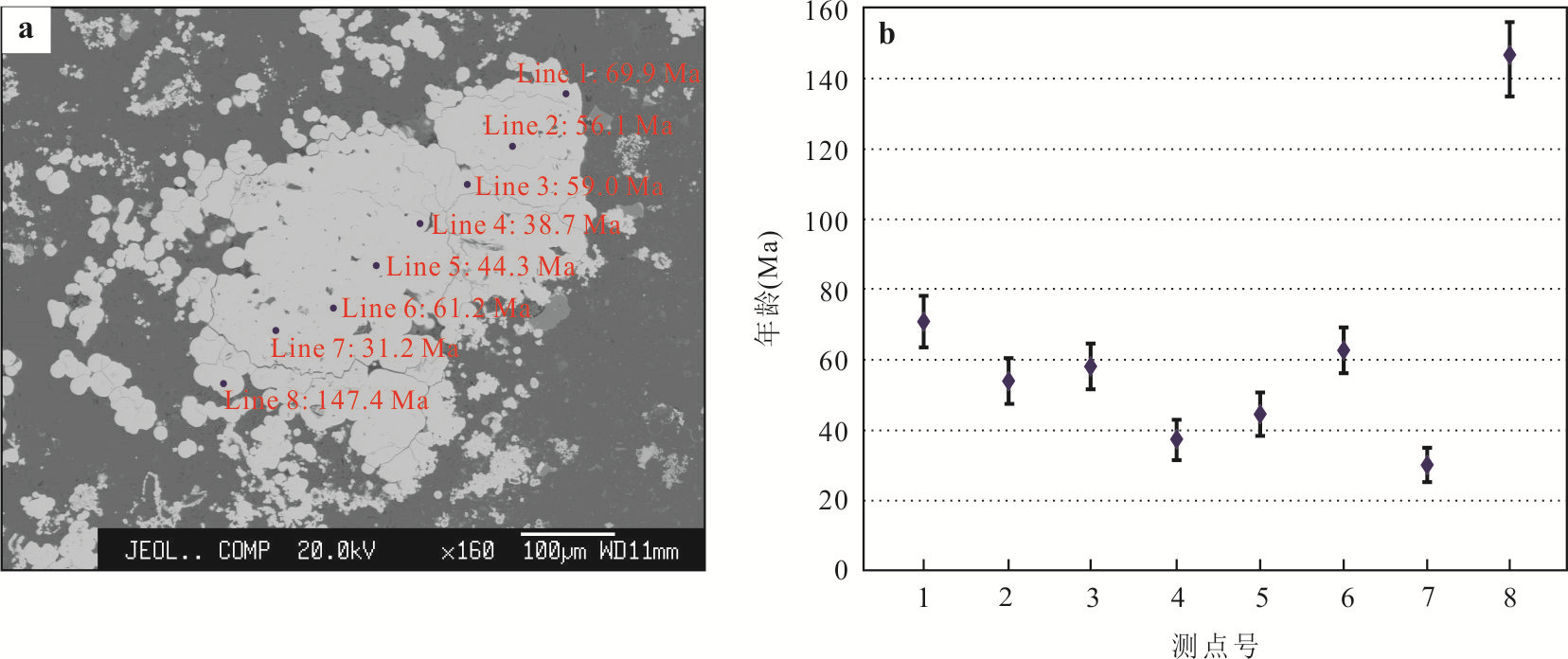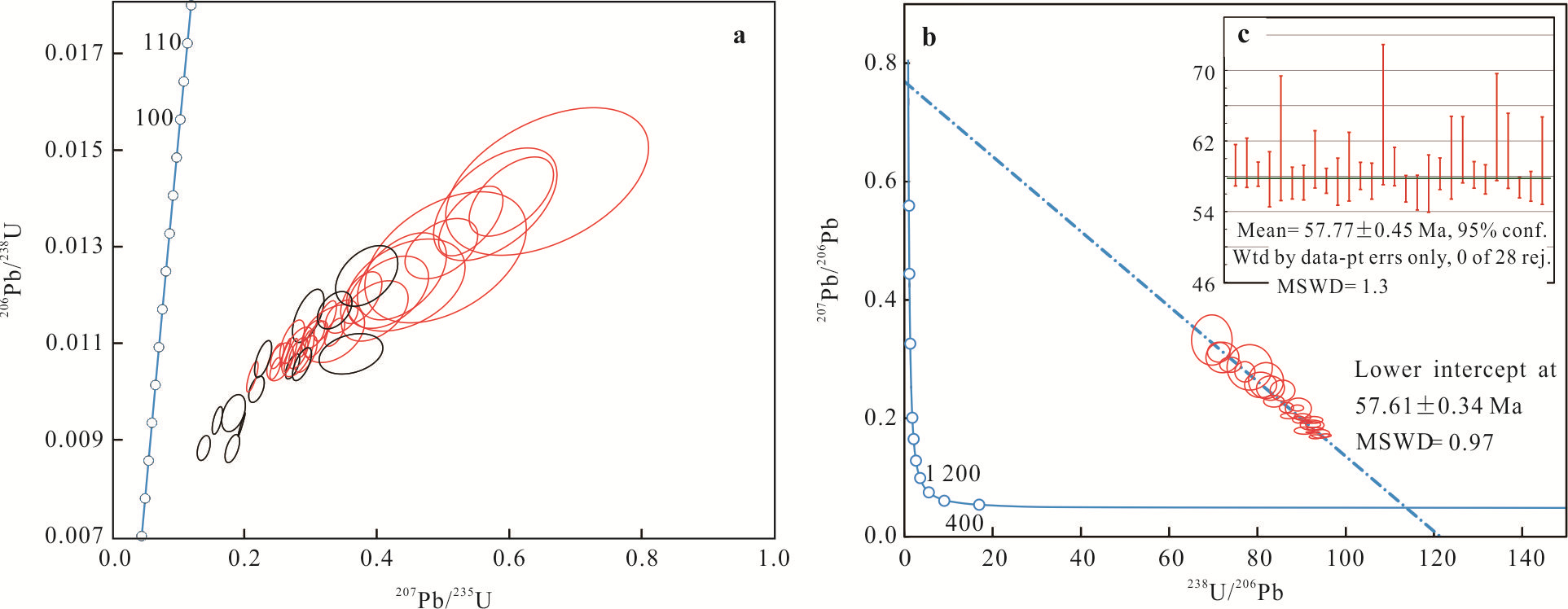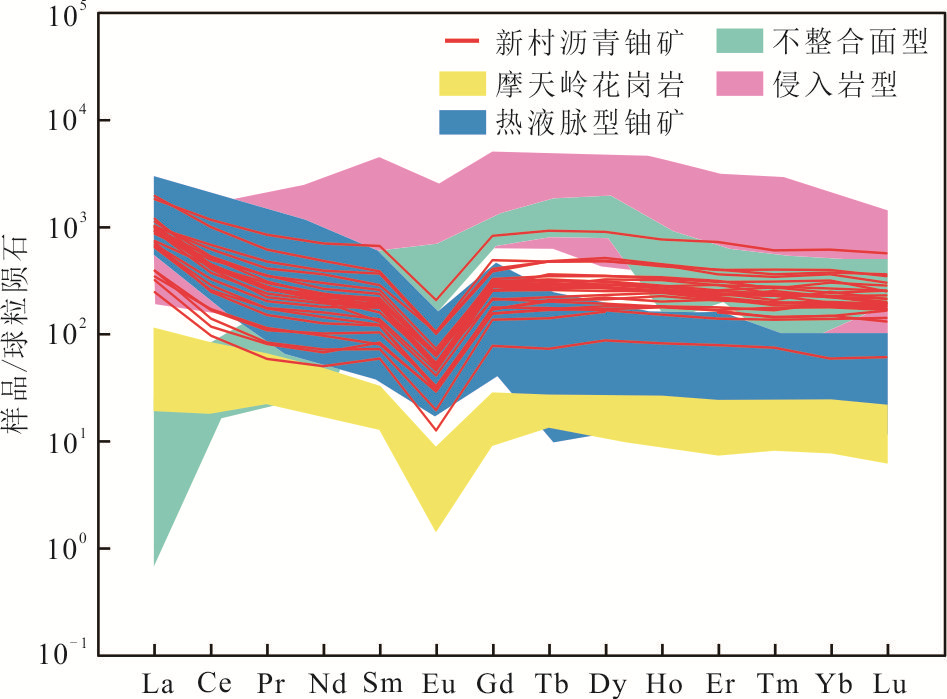In-Situ Geochronology and Geochemistry of Pitchblende from Xincun Uranium Deposit in Motianling Area, North Guangxi
-
摘要: 为深入探究桂北摩天岭花岗岩体中新村铀矿床的精确成矿时代及矿床成因,利用微区原位分析技术(SEM、EPMA和LA-ICP-MS)对主成矿期(铀-硅化型)沥青铀矿开展了详细的矿相学观察、原位U-Pb定年和化学成分分析.沥青铀矿电子探针化学定年计算得到的年龄值变化范围极大,不能准确地反映矿床的大致形成时间.LA-ICP-MS U-Pb同位素分析结果表明,新村矿床沥青铀矿含有一定量的普通铅,采用Tera-Wasserburg图解法得到一个下交点年龄为57.61±0.34 Ma(MSWD=0.97),可以代表主成矿期的矿化年龄.新村矿床沥青铀矿具有较高的WO3、CaO和极低的ThO含量,暗示成矿流体可能为富U、W的中低温成因流体;沥青铀矿稀土元素配分模式为轻稀土微富集型,整体上与赋矿花岗岩稀土配分型式相似,指示成矿物质可能来自花岗岩体本身.新获得的铀成矿年龄与桂北地区热液型铀矿的主成矿期(70~50 Ma)基本一致,表明新村矿床同华南地区绝大多数中新生代热液铀矿床一样,都是白垩纪-古近纪岩石圈伸展减薄背景之下的产物.Abstract: To better determine the precise mineralization age and examine the genesis of the Xincun uranium deposit in Motianling granite, North Guangxi, it carried out detailed mineralogical observation, in-situ U-Pb isotope and chemical composition analysis on the pitchblende of U-silicified type mineralization from the Xincun deposit using scanning electron microscopy (SEM), electron probe (EPMA) and laser ablation inductively coupled plasma mass spectrometry (LA-ICP-MS). The chemical age of pitchblende obtained by the electron probe gives a very wide range and thus cannot represent the true formation age of the Xincun uranium mineralization. The results of LA-ICP-MS U-Pb isotope indicate that the pitchblende of the Xincun deposit contains a certain amount of common Pb, and the Tera-Wasserburg diagram yields a lower intercept age of 57.61±0.34 Ma (MSWD=0.97), which can represent the exact timing of Xincun deposit. The major and trace element results show that the pitchblende of the Xincun deposit has high WO3 and CaO contents but extremely low ThO content, indicating that the ore fluid may be enriched in U and W and has medium-low temperature. The chondrite-normalized patterns of rare earth elements in pitchblende are slightly rich in light-REE, and similar to the rare earth partition of the ore-hosting granite. It is thus speculated that the uranium is probably derived from the granitoid itself. The newly obtained mineralization age is consistent with the main metallogenic period (70-50 Ma) of the hydrothermal uranium deposits in northern Guangxi. Similar to most of the Mesozoic and Cenozoic hydrothermal uranium deposits in South China, the Xincun deposit was formed due to the extension and thinning of the Cretaceous-Paleogene lithosphere in South China.
-
Key words:
- micro-area analysis /
- U-Pb dating /
- pitchblende /
- Xincun uranium deposit /
- Motianling area /
- Guangxi /
- ore deposit geology
-
图 1 桂北摩天岭-元宝山区域地质简图(据宋昊等,2015;徐争启等,2019修改)
1.第四系;2.寒武系;3.震旦系;4.丹洲群;5.四堡群;6.新元古代雪峰期花岗岩;7.新元古代雪峰期花岗混合岩;8.晚中元古代花岗闪长岩;9.中元古代基性-超基性岩;10.新村式铀矿床(点);11.达亮式铀矿床(点);12.断裂;13.地层不整合界线;14.中酸性岩脉
Fig. 1. The sketch geological map of Motianling-Yuanbaoshan area in North Guangxi (after Song et al., 2015; Xu et al., 2019)
图 3 新村铀矿床新鲜围岩、蚀变岩石和富矿石野外及显微镜下照片
a. 新村矿床钻孔中的新鲜花岗岩(围岩);b. 矿化围岩中发育强烈的面状钾长石化;c. 强烈蚀变花岗岩,发育钾长石化、黄铁矿化和水云母化;d. 典型的铀-硅化型富矿石,可见清晰的黑色沥青铀矿细脉,伴有强烈的硅化和黄铁矿化;e. 典型的铀-萤石型矿石,萤石-黄铁矿-沥青铀矿脉切穿早期的硅化石英脉;f. 铀硅化型矿石中微晶石英与沥青铀矿密切共生(正交偏光镜下).Urn. 沥青铀矿;Flu. 萤石;Hem. 赤铁矿;Kf. 钾化长石;Ser. 水云母化;Py. 黄铁矿;Qz. 石英
Fig. 3. Field photographs and microscope photographs of unaltered, altered and mineralized rocks from Xincun uranium deposit
图 4 新村铀矿床铀-硅化型富矿石中沥青铀矿镜下照片及背散射照片
a. 铀-硅化型矿石光薄片,黑色沥青铀矿脉清晰可见;b. 黄铁矿、微晶石英与沥青铀矿共生(反射光镜下);c. 同心圆状、葡萄状沥青铀矿集合体;d. 沥青铀矿与黄铁矿相互包裹共生.Urn. 沥青铀矿;Coff. 铀石;Py. 黄铁矿;Qz. 石英
Fig. 4. Microscope photographs and backscattered electron images of pitchblende in the high-grade U-silicified type ore samples from Xincun deposit
图 9 沥青铀矿的球粒陨石标准化稀土元素配分图
标准化值引自Sun and McDonough(1989),其他类型沥青铀矿稀土元素数据来自Mercadier et al.(2011),摩天岭花岗岩稀土数据引自邱检生等(2002)和韩宗珠等(2012)
Fig. 9. Chondrite-normalized REE pattern diagram of the pitchblende from Xincun deposit
-
Alexandre, P., Kyser, T. K., 2005. Effects of Cationic Substitutions and Alteration in Uraninite, and Implications for the Dating of Uranium Deposits. The Canadian Mineralogist, 43(3): 1005-1017. https://doi.org/10.2113/gscanmin.43.3.1005 Ballouard, C., Poujol, M., Mercadier, J., et al., 2018. Uranium Metallogenesis of the Peraluminous Leucogranite from the Pontivy-Rostrenen Magmatic Complex (French Armorican Variscan Belt): The Result of Long-Term Oxidized Hydrothermal Alteration during Strike-Slip Deformation. Mineralium Deposita, 53(5): 601-628. https://doi.org/10.1007/s00126-017-0761-5 Bowles, J. F. W., 1990. Age Dating of Individual Grains of Uraninite in Rocks from Electron Microprobe Analyses. Chemical Geology, 83(1/2): 47-53. https://doi.org/10.1016/0009-2541(90)90139-X Chen, Y. H., Chen, Z. Y., Cai, Y. Q., et al., 1996. Mesozoic-Cenozoic Extensional Structural Types and Their Main Characteristics in Southeastern China. Uranium Geology, 12(5): 257-261 (in Chinese with English abstract). Chen, Y. W., Hu, R. Z., Luo, J. C., et al., 2019. In-Situ Mineral Chemistry and Chronology Analyses of the Pitchblende in the Hazijiang Uranium Deposit and Their Implications for Mineralization. Acta Petrologica Sinica, 35(9): 2679-2694 (in Chinese with English abstract). doi: 10.18654/1000-0569/2019.09.04 Chi, G. X., Ashton, K., Deng, T. X., et al., 2020. Comparison of Granite-Related Uranium Deposits in the Beaverlodge District (Canada) and South China: A Common Control of Mineralization by Coupled Shallow and Deep-Seated Geologic Processes in an Extensional Setting. Ore Geology Reviews, 117: 103319. https://doi.org/10.1016/j.oregeorev.2020.103319 Frimmel, H. E., Schedel, S., Brätz, H., 2014. Uraninite Chemistry as Forensic Tool for Provenance Analysis. Applied Geochemistry, 48: 104-121. https://doi.org/10.1016/j.apgeochem.2014.07.013 Ge, X. K., 2013. Development and Research of Electron Probe Dating Technology in Uranium and Uranium-Bearing Materials Dating (Dissertation). Beijing Research Institute of Uranium Geology, Beijing (in Chinese with English abstract). Guo, C. Y., Qin, M. K., Xu, H., et al., 2020. Age of Zhangjia Uranium Deposit in the Miaoershan Ore Field, Guangxi Autonomous Region, China: In Situ Micro-Determination on Pitchblende. Earth Science, 45(1): 72-89 (in Chinese with English abstract). Han, Z. Z., Yi, W. H., Li, S. Z., et al., 2012. Geochemistry and Petrogenesis of Granitoid Rocks in Motianling Area and Yuanbaoshan Area, Northern Guangxi. Periodical of Ocean University of China, 42(4): 59-65 (in Chinese with English abstract). Hu, R. Z., Bi, X. W., Peng, J. T., et al., 2007. Some Problems Concerning Relationship between Mesozoic-Cenozoic Lithospheric Extension and Uranium Metallogenesis in South China. Mineral Deposits, 26(2): 139-152 (in Chinese with English abstract). doi: 10.3969/j.issn.0258-7106.2007.02.001 Hu, R. Z., Bi, X. W., Zhou, M. F., et al., 2008. Uranium Metallogenesis in South China and Its Relationship to Crustal Extension during the Cretaceous to Tertiary. Economic Geology, 103(3): 583-598. https://doi.org/10.2113/gsecongeo.103.3.583 Huang, H., Wang, K. X., Cuney, M., et al., 2022. Mesozoic Magmatic and Hydrothermal Uranium Mineralization in the Huayangchuan Carbonatite-Hosted U-Nb-Polymetallic Deposit, North Qinling Orogen (Central China): Evidence from Uraninite Chemical and Isotopic Compositions. Ore Geology Reviews, 146: 104958. https://doi.org/10.1016/j.oregeorev.2022.104958 Kempe, U., 2003. Precise Electron Microprobe Age Determination in Altered Uraninite: Consequences on the Intrusion Age and the Metallogenic Significance of the Kirchberg Granite (Erzgebirge, Germany). Contributions to Mineralogy and Petrology, 145(1): 107-118. https://doi.org/10.1007/s00410-002-0439-5 Kotzer, T. G., Kyser, T. K., 1993. O, U, and Pb Isotopic and Chemical Variations in Uraninite: Implications for Determining the Temporal and Fluid History of Ancient Terrains. American Mineralogist, 78(11-12): 1262-1274. Lai, J., Qi, J. M., Chen, J. J., et al., 2020. Uranium Micromineralogy and Geochronology of the Jiangtou Uranium Ore Field in the Qingzhangshan Granite Pluton, North Guangdong: Constraints on the Genetic Relationship with Metallogenic Dynamic Background. Acta Geologica Sinica, 94(4): 1128-1142 (in Chinese with English abstract). doi: 10.3969/j.issn.0001-5717.2020.04.008 Li, J. W., Zhao, X. F., 2022. How does the Continental Rift Control the Material Cycle and Metal Mineralization in the Stratosphere? Earth Science, 47(10): 3872-3873(in Chinese with English abstract). Liu, Y. S., Hu, Z. C., Gao, S., et al., 2008. In Situ Analysis of Major and Trace Elements of Anhydrous Minerals by LA-ICP-MS without Applying an Internal Standard. Chemical Geology, 257(1/2): 34-43. https://doi.org/10.1016/j.chemgeo.2008.08.004 Luo, J. C., Hu, R. Z., Fayek, M., et al., 2017. Newly Discovered Uranium Mineralization at ~2.0 Ma in the Menggongjie Granite-Hosted Uranium Deposit, South China. Journal of Asian Earth Sciences, 137: 241-249. https://doi.org/10.1016/j.jseaes.2017.01.021 Luo, J. C., Hu, R. Z., Shi, S. H., 2015. Timing of Uranium Mineralization and Geological Implications of Shazijiang Granite-Hosted Uranium Deposit in Guangxi, South China: New Constraint from Chemical U-Pb Age. Journal of Earth Science, 26(6): 911-919. https://doi.org/10.1007/s12583-015-0542-y Luo, J. C., Shi, S. H., Chen, Y. W., et al., 2019. Review on Dating of Uranium Mineralization. Acta Petrologica Sinica, 35(2): 589-605 (in Chinese with English abstract). Mao, J. W., 1987. Geological Features and Minerogenic Series of the Tin Polymetallic Deposits in Jiuwandashan-Yuanbaoshan Area, Northern Guangxi. Mineral Deposits, 6(4): 23-32 (in Chinese with English abstract). Mao, J. W., Xie, G. Q., Guo, C. L., et al., 2008. Spatial-Temporal Distribution of Mesozoic Ore Deposits in South China and Their Metallogenic Settings. Geological Journal of China Universities, 14(4): 510-526 (in Chinese with English abstract). doi: 10.3969/j.issn.1006-7493.2008.04.005 Martz, P., Mercadier, J., Perret, J., et al., 2019. Post-Crystallization Alteration of Natural Uraninites: Implications for Dating, Tracing, and Nuclear Forensics. Geochimica et Cosmochimica Acta, 249: 138-159. https://doi.org/10.1016/j.gca.2019.01.025 Mercadier, J., Cuney, M., Lach, P., et al., 2011. Origin of Uranium Deposits Revealed by Their Rare Earth Element Signature. Terra Nova, 23(4): 264-269. https://doi.org/10.1111/j.1365-3121.2011.01008.x Palacios, C. M., Hein, U. F., Dulski, P., 1986. Behaviour of Rare Earth Elements during Hydrothermal Alteration at the Buena Esperanza Copper-Silver Deposit, Northern Chile. Earth and Planetary Science Letters, 80(3-4): 208-216. https://doi.org/10.1016/0012-821x(86)90105-6 Pang, Y. H., 1997. Metallogenic Characteristics of a Rare Uranium-Tungsten Mineralization Belt. Geochimica, 26(4): 86-93 (in Chinese with English abstract). Qin, K. Z., Li, H. M., Li, W. S., et al., 1999. Intrusion and Mineralization Ages of the Wunugetushan Porphyry Cu-Mo Deposit, Inner Mongolia, Northwestern China. Geological Review, 45(2): 180-185 (in Chinese with English abstract). doi: 10.3321/j.issn:0371-5736.1999.02.011 Qin, K. Z., Wang, Z. T., 1993. Rare Earth Element Behaviour in the Wunugetushan Cu-Mo Deposit, Inner Mongolia, and Its Significance. Acta Geologica Sinica, 67(4): 323-335 (in Chinese with English abstract). Qiu, J. S., Zhou, J. C., Zhang, G. H., et al., 2002. Geochemistry and Petrogenesis of Precambrian Granitoid Rocks in Northern Guangxi. Acta Petrologica et Mineralogica, 21(3): 197-208 (in Chinese with English abstract). doi: 10.3969/j.issn.1000-6524.2002.03.001 Qiu, L., Yan, D. P., Ren, M., et al., 2018. The Source of Uranium within Hydrothermal Uranium Deposits of the Motianling Mining District, Guangxi, South China. Ore Geology Reviews, 96: 201-217. https://doi.org/10.1016/j.oregeorev.2018.04.001 Qiu, L., Yan, D. P., Tang, S. L., et al., 2015. Cooling and Exhumation of the Oldest Sanqiliu Uranium Ore System in Motianling District, South China Block. Terra Nova, 27(6): 449-457. https://doi.org/10.1111/ter.12179 Ranchin, G., 1968. Contribution à 1'étude de la Répartitionde l'uranium à 1'état de Traces dans les Roches Granitiques Saines les Uranitesàteneur élevée du Massif de Saint-Sylvestre (Limousin-Massif Gentral Francal). Science Terre, 13: 161-205 (in French). Richard, A., Cathelineau, M., Boiron, M. C., et al., 2016. Metal-Rich Fluid Inclusions Provide New Insights into Unconformity-Related U Deposits (Athabasca Basin and Basement, Canada). Mineralium Deposita, 51(2): 249-270. https://doi.org/10.1007/s00126-015-0601-4 Shi, S. H., Hu, R. Z., Wen, H. J., et al., 2010. Geochronology of the Shazijiang Uranium Ore Deposit, Northern Guangxi, China: U-Pb Ages of Pitchblende and Their Geological Significance. Acta Geologica Sinica, 84(8): 1175-1182 (in Chinese with English abstract). Song, H., Xu, Z. Q., Ni, S. J., et al., 2015. Response of the Motianling Granitic Pluton in North Guangxi to the Tectonic Evolution in the Southwestern Section of the Jiangnan Orogenic Belt: Constraints from Neoproterozoic Zircon Geochronology. Geotectonica et Metallogenia, 39(6): 1156-1175 (in Chinese with English abstract). Sun, S. S., McDonough, W. F., 1989. Chemical and Isotopic Systematics of Oceanic Basalts: Implications for Mantle Composition and Processes. Geological Society, London, Special Publications, 42(1): 313-345. https://doi.org/10.1144/gsl.sp.1989.042.01.19 Tan, S., Chen, Q., Wan, J. J., et al., 2022. Study on Metallogenic Age of Xiangyangping Deposit in Miaoershan Uranium Field, Guangxi. Atomic Energy Science and Technology, 56(S1): 211-224 (in Chinese with English abstract). Tera, F., Wasserburg, G. J., 1972. U-Th-Pb Systematics in Lunar Highland Samples from the Luna 20 and Apollo 16 Missions. Earth and Planetary Science Letters, 17(1): 36-51. https://doi.org/10.1016/0012-821X(72)90257-9 Tian, H., Fu, X. Q., Huang, J. H., 2020. Study on the Geological Mineralization of Yuanbaoshan Rock Body and Its Surroundings in Guangxi. World Nonferrous Metals, (5): 230-231 (in Chinese with English abstract). Wang, Y. J., Fan, H. H., Pang, Y. Q., et al., 2022. Geochemical Characteristics of Chlorite in Xiangshan Uranium Ore Field, South China and Its Exploration Implication. Minerals, 12(6): 693. https://doi.org/10.3390/min12060693 Wang, Y. J., Fan, W. M., Zhang, G. W., et al., 2013. Phanerozoic Tectonics of the South China Block: Key Observations and Controversies. Gondwana Research, 23(4): 1273-1305. https://doi.org/10.1016/j.gr.2012.02.019 Wang, Y. J., Nie, J. T., Lin, J. R., et al., 2022. Mineralization Characteristics and Geochemical Elements Migration during Alkali Metasomatized Hydrothermal Process of Yunji Deposit in Xiangshan Uranium Ore Field. Acta Petrologica Sinica, 38(9): 2865-2888 (in Chinese with English abstract). Wang, Z. Q., 2018. Study on Metallogenic Mechanism of Miaoershan Granite-Type Uranium Deposit in Guangxi (Dissertation). Beijing Research Institute of Uranium Geology, Beijing (in Chinese with English abstract). Wu, Y., Qin, M. K., Guo, D. F., et al., 2020. Metallogenic Chronology of the Pitchblende of 1101 Uranium Ore Area in Mouding, Middle-South Part of the Kangdian Axis and Its Geological Significance. Earth Science, 45(2): 419-433 (in Chinese with English abstract). Xiao, W., Fan, H. H., Chen, D. H., et al., 2022a. Genesis of the Guangzitian Uranium-Tungsten Deposit in Northern Guangxi: Geochemical Evidences from In-Situ U-Pb Dating of Pitchblende and Mineral Geochemistry. Geological Review, 68(3): 831-844 (in Chinese with English abstract). Xiao, W., Fan, H. H., Pang, Y. Q., et al., 2022b. Geochronology and Mineral Chemistry Study on Huziduishan Uranium Deposit in Northern Guangdong Province and Its Implications for Uranium Mineralization. Mineral Deposits, 41(2): 383-402 (in Chinese with English abstract). Xu, Z. Q., Song, H., Yin, M. H., et al. 2019. Uranium Mineralization Mechanism of Neoproterozoic Granites in South China: A Case Study of the Motianling Granite. Acta Petrologica Sinica, 35(9): 2695-2710 (in Chinese with English abstract). Yan, D. P., Zhou, M. F., Song, H. L., et al., 2003. Origin and Tectonic Significance of a Mesozoic Multi-Layer Over-Thrust System within the Yangtze Block (South China). Tectonophysics, 361(3-4): 239-254. https://doi.org/10.1016/S0040-1951(02)00646-7 Zhang, C., Cai, Y. Q., Dong, Q., et al., 2019. Genesis of the South Zhuguang Uranium Ore Field, South China: Pb Isotopic Compositions and Mineralization Ages. Resource Geology, 69(1): 22-42. https://doi.org/10.1111/rge.12184 Zhang, C., Cai, Y. Q., Dong, Q., et al., 2020. Cretaceous-Neogene Basin Control on the Formation of Uranium Deposits in South China: Evidence from Geology, Mineralization Ages, and H-O Isotopes. International Geology Review, 62(3): 263-310. https://doi.org/10.1080/00206814.2019.1598898 Zhang, C., Richard, A., Hao, W., et al., 2022. Trace Metals in Saline Waters and Brines from China: Implications for Tectonic and Climatic Controls on Basin-Related Mineralization. Journal of Asian Earth Sciences, 233: 105263. https://doi.org/10.1016/j.jseaes.2022.105263 Zhang, L., Chen, Z. Y., Tian, Z. J., et al., 2016. The Application of Electron Microprobe Dating Method on Uranium Minerals in Changjiang Granite, Northern Guangdong. Rock and Mineral Analysis, 35(1): 98-107 (in Chinese with English abstract). Zhang, L., Chen, Z. Y., Wang, F. Y., et al., 2021. Release of Uranium from Uraninite in Granites through Alteration: Implications for the Source of Granite-Related Uranium Ores. Economic Geology, 116(5): 1115-1139. https://doi.org/10.5382/econgeo.4822 Zhang, Z. H., Shen, W. Z., Rao, B., 1984. A Study on the Isotopic Geology of No. 376 Uranium Deposit. Journal of Nanjing University (Natural Sciences), 20(3): 543-553 (in Chinese with English abstract). Zhao, J. H., Zhou, M. F., Zheng, J. P., 2013. Constraints from Zircon U-Pb Ages, O and Hf Isotopic Compositions on the Origin of Neoproterozoic Peraluminous Granitoids from the Jiangnan Fold Belt, South China. Contributions to Mineralogy and Petrology, 166(5): 1505-1519. https://doi.org/10.1007/s00410-013-0940-z Zhao, K. D., Jiang, S. Y., Ling, H. F., et al., 2014. Reliability of LA-ICP-MS U-Pb Dating of Zircons with High U Concentrations: A Case Study from the U-Bearing Douzhashan Granite in South China. Chemical Geology, 389: 110-121. https://doi.org/10.1016/j.chemgeo.2014.09.018 Zheng, G. D., Luo, Q., Liu, W. Q., et al., 2021. In-Situ U-Pb Age and Elemental Characteristics of Pitchblende in Shulouqiu Uranium Deposit and Its Geological Significance. Earth Science, 46(6): 2172-2187(in Chinese with English abstract). Zhong, F. J., Yan, J., Xia, F., et al., 2019. In-Situ U-Pb Isotope Geochronology of Uraninite for Changjiang Granite-Type Uranium Ore Field in Northern Guangdong, China: Implications for Uranium Mineralization. Acta Petrologica Sinica, 35(9): 2727-2744 (in Chinese with English abstract). Zhu, K. H., Dai, J. W., Wang, K. X., et al., 2022. Age and Genesis of Pitchblende of the Haidewula Uranium Deposit, East Kunlun Orogen and Its Geological Significance. Earth Science, 47(8): 2940-2950(in Chinese with English abstract). Zong, K. Q., Chen, J. Y., Hu, Z. C., et al., 2015. In-Situ U-Pb Dating of Uraninite by Fs-LA-ICP-MS. Scientia Sinica (Terrae), 45(9): 1304-1319 (in Chinese). 陈佑纬, 胡瑞忠, 骆金诚, 等, 2019. 桂北沙子江铀矿床沥青铀矿原位微区年代学和元素分析: 对铀成矿作用的启示. 岩石学报, 35(9): 2679-2694. https://www.cnki.com.cn/Article/CJFDTOTAL-YSXB201909004.htm 陈跃辉, 陈祖伊, 蔡煜琦, 等, 1996. 华东南中新生代伸展构造类型及其主要特征. 铀矿地质, 12(5): 257-261. https://www.cnki.com.cn/Article/CJFDTOTAL-YKDZ605.000.htm 葛祥坤, 2013. 电子探针定年技术在铀及含铀矿物测年中的开发与研究(博士学位论文). 北京: 核工业北京地质研究院. 郭春影, 秦明宽, 徐浩, 等, 2020. 广西苗儿山铀矿田张家铀矿床成矿时代: 沥青铀矿微区原位测定. 地球科学, 45(1): 72-89. doi: 10.3799/dqkx.2018.227?viewType=HTML 韩宗珠, 衣伟虹, 李三忠, 等, 2012. 桂北摩天岭和元宝山花岗岩类岩石地球化学及成因研究. 中国海洋大学学报(自然科学版), 42(4): 59-65. https://www.cnki.com.cn/Article/CJFDTOTAL-QDHY201204010.htm 胡瑞忠, 毕献武, 彭建堂, 等, 2007. 华南地区中生代以来岩石圈伸展及其与铀成矿关系研究的若干问题. 矿床地质, 26(2): 139-152. https://www.cnki.com.cn/Article/CJFDTOTAL-KCDZ200702000.htm 赖静, 祁家明, 陈军军, 等, 2020. 粤北青嶂山岩体江头矿区铀矿微区矿物学、年代学特征及其成矿动力背景制约. 地质学报, 94(4): 1128-1142. https://www.cnki.com.cn/Article/CJFDTOTAL-DZXE202004008.htm 李建威, 赵新福, 2022. 大陆裂谷如何控制层圈物质循环及金属成矿作用? 地球科学, 47(10): 3872-3873. doi: 10.3799/dqkx.2022.845?viewType=HTML 骆金诚, 石少华, 陈佑纬, 等, 2019. 铀矿床定年研究进展评述. 岩石学报, 35(2): 589-605. https://www.cnki.com.cn/Article/CJFDTOTAL-YSXB201902019.htm 毛景文, 1987. 桂北九万大山—元宝山地区锡多金属矿床的地质特征和成矿系列. 矿床地质, 6(4): 23-32. https://www.cnki.com.cn/Article/CJFDTOTAL-KCDZ198704003.htm 毛景文, 谢桂青, 郭春丽, 等, 2008. 华南地区中生代主要金属矿床时空分布规律和成矿环境. 高校地质学报, 14(4): 510-526. https://www.cnki.com.cn/Article/CJFDTOTAL-GXDX200804007.htm 庞玉蕙, 1997. 一个罕见的铀钨矿化带的成矿特征. 地球化学, 26(4): 86-93. https://www.cnki.com.cn/Article/CJFDTOTAL-DQHX704.009.htm 秦克章, 李惠民, 李伟实, 等, 1999. 内蒙古乌奴格吐山斑岩铜钼矿床的成岩、成矿时代. 地质论评, 45(2): 180-185. https://www.cnki.com.cn/Article/CJFDTOTAL-DZLP199902014.htm 秦克章, 王之田, 1993. 内蒙古乌奴格吐山铜-钼矿床稀土元素的行为及意义. 地质学报, 67(4): 323-335. https://www.cnki.com.cn/Article/CJFDTOTAL-DZXE199304003.htm 邱检生, 周金城, 张光辉, 等, 2002. 桂北前寒武纪花岗岩类岩石的地球化学与成因. 岩石矿物学杂志, 21(3): 197-208. https://www.cnki.com.cn/Article/CJFDTOTAL-YSKW200203000.htm 石少华, 胡瑞忠, 温汉捷, 等, 2010. 桂北沙子江铀矿床成矿年代学研究: 沥青铀矿U-Pb同位素年龄及其地质意义. 地质学报, 84(8): 1175-1182. https://www.cnki.com.cn/Article/CJFDTOTAL-DZXE201008011.htm 宋昊, 徐争启, 倪师军, 等, 2015. 广西摩天岭岩体对江南造山带西南段构造演化的响应: 来自新元古代花岗岩锆石U-Pb年代学证据. 大地构造与成矿学, 39(6): 1156-1175. https://www.cnki.com.cn/Article/CJFDTOTAL-DGYK201506016.htm 谭双, 陈琪, 万建军, 等, 2022. 广西苗儿山铀矿田向阳坪矿床成矿时代研究. 原子能科学技术, 56(增刊1): 211-224. https://www.cnki.com.cn/Article/CJFDTOTAL-YZJS2022S1025.htm 田华, 付秀琪, 黄金辉, 2020. 广西元宝山岩体及其周边的地质成矿的研究. 世界有色金属, (5): 230-231. https://www.cnki.com.cn/Article/CJFDTOTAL-COLO202005138.htm 王勇剑, 聂江涛, 林锦荣, 等, 2022. 相山铀矿田云际矿床碱交代型铀矿化蚀变作用及组分迁移规律研究. 岩石学报, 38(9): 2865-2888. https://www.cnki.com.cn/Article/CJFDTOTAL-YSXB202209020.htm 王正庆, 2018. 广西苗儿山花岗岩型铀矿床成矿机制研究(博士学位论文). 北京: 核工业北京地质研究院. 武勇, 秦明宽, 郭冬发, 等, 2020. 康滇地轴中南段牟定1101铀矿区沥青铀矿成矿时代及成因. 地球科学, 45(2): 419-433. doi: 10.3799/dqkx.2019.058?viewType=HTML 肖为, 范洪海, 陈东欢, 等, 2022a. 桂北广子田铀钨矿床成因: 沥青铀矿原位U-Pb定年、矿物地球化学证据. 地质论评, 68(3): 831-844. https://www.cnki.com.cn/Article/CJFDTOTAL-DZLP202203005.htm 肖为, 范洪海, 庞雅庆, 等, 2022b. 粤北湖子对山铀矿床年代学与矿物化学研究及其对铀成矿的启示. 矿床地质, 41(2): 383-402. https://www.cnki.com.cn/Article/CJFDTOTAL-KCDZ202202011.htm 徐争启, 宋昊, 尹明辉, 等, 2019. 华南地区新元古代花岗岩铀成矿机制: 以摩天岭花岗岩为例. 岩石学报, 35(9): 2695-2710. https://www.cnki.com.cn/Article/CJFDTOTAL-YSXB201909005.htm 张龙, 陈振宇, 田泽瑾, 等, 2016. 电子探针测年方法应用于粤北长江岩体的铀矿物年龄研究. 岩矿测试, 35(1): 98-107. https://www.cnki.com.cn/Article/CJFDTOTAL-YKCS201601018.htm 张祖还, 沈渭洲, 饶冰, 1984.376铀矿床的同位素地质研究. 南京大学学报(自然科学版), 20(3): 543-553. https://www.cnki.com.cn/Article/CJFDTOTAL-NJDZ198403016.htm 郑国栋, 罗强, 刘文泉, 等, 2021. 粤北书楼丘铀矿床沥青铀矿原位U-Pb年龄和元素特征及其地质意义. 地球科学, 46(6): 2172-2187. doi: 10.3799/dqkx.2020.225?viewType=HTML 钟福军, 严杰, 夏菲, 等, 2019. 粤北长江花岗岩型铀矿田沥青铀矿原位U-Pb年代学研究及其地质意义. 岩石学报, 35(9): 2727-2744. https://www.cnki.com.cn/Article/CJFDTOTAL-YSXB201909007.htm 朱坤贺, 戴佳文, 王凯兴, 等, 2022. 东昆仑造山带海德乌拉铀矿床沥青铀矿年代学特征及成因. 地球科学, 47(8): 2940-2950. doi: 10.3799/dqkx.2021.216?viewType=HTML 宗克清, 陈金勇, 胡兆初, 等, 2015. 铀矿fs-LA-ICP-MS原位微区U-Pb定年. 中国科学: 地球科学, 45(9): 1304-1319. https://www.cnki.com.cn/Article/CJFDTOTAL-JDXK201509005.htm -
 dqkxzx-49-4-1307-附表1-3.docx
dqkxzx-49-4-1307-附表1-3.docx

-









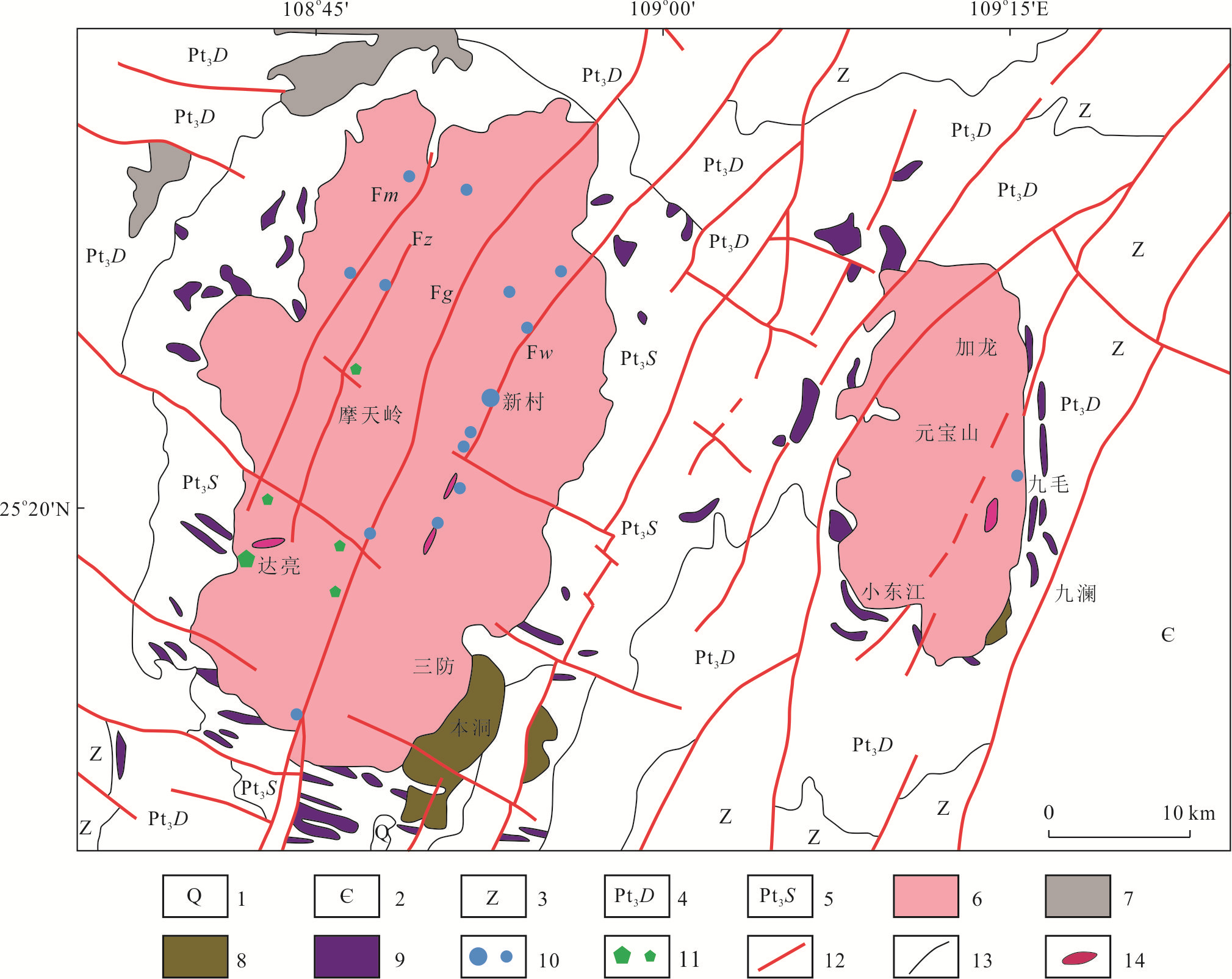
 下载:
下载:
